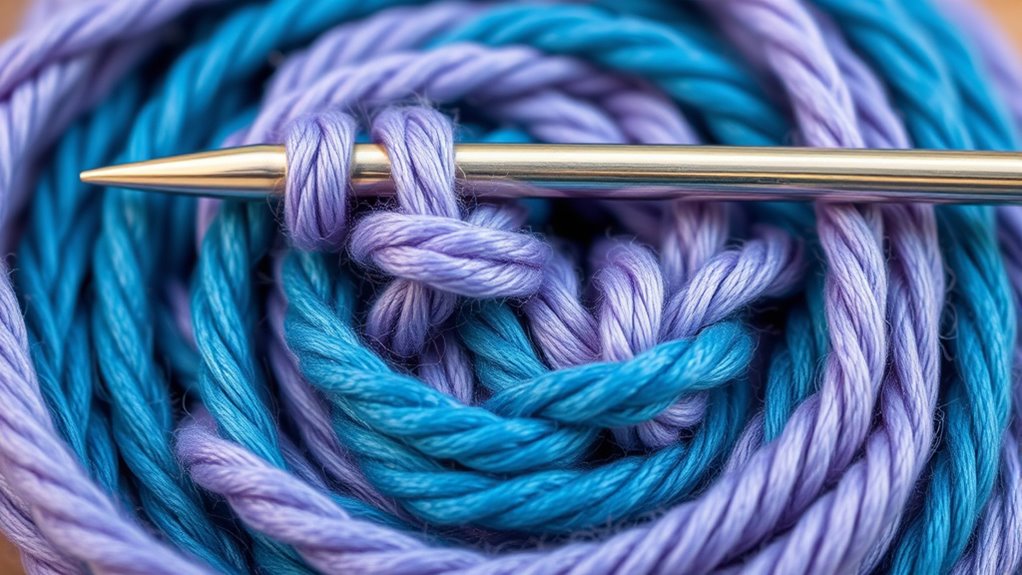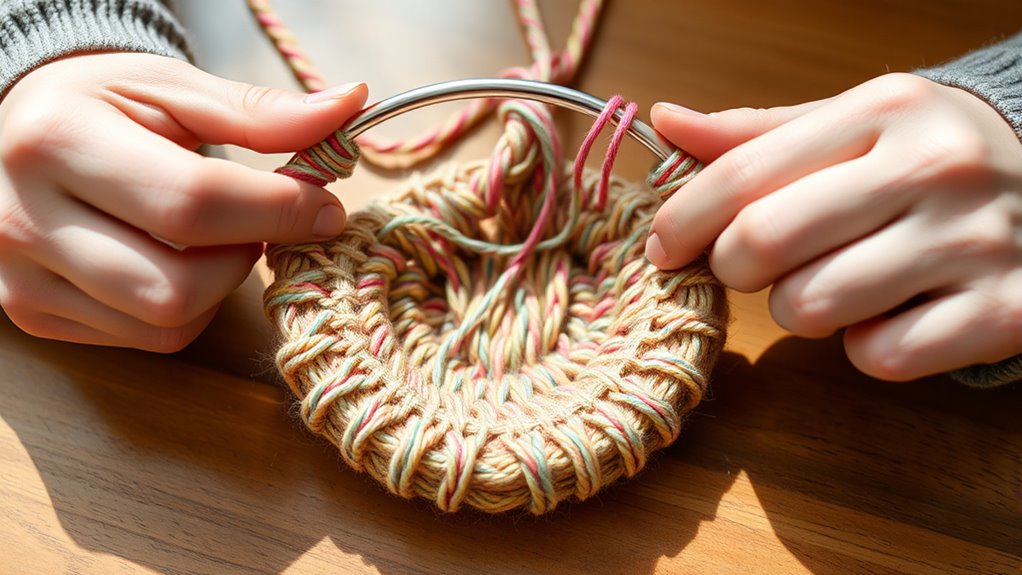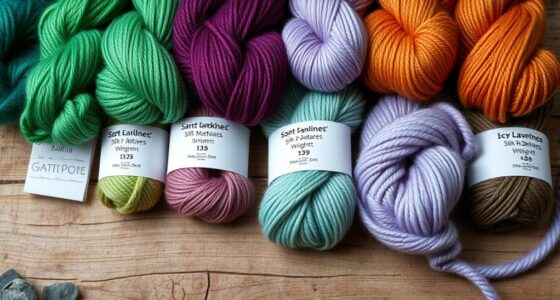To knit small circles with the magic loop technique, you need a long circular needle (at least 32 inches). Divide your stitches into two halves on the cable, with one half on each side of the needle tip. Use the tip to knit while the cable holds the other stitches, then shift the stitches over the cable to keep knitting in the round smoothly. Mastering tension and stitch management makes this process seamless—continue exploring to discover all the tips and tricks.
Key Takeaways
- Use a 32-inch or longer circular needle to divide stitches into two halves for seamless small circle knitting.
- Divide stitches evenly on the cable, with one half on the needle tip and the other on the cable.
- Knit one half of the stitches, then slide the work to the other tip, pulling the cable to create a loop for the next round.
- Maintain consistent yarn tension throughout to ensure even stitches and smooth transitions between rounds.
- Practice shifting stitches over the cable to manage tension and prevent bunching or slipping, ensuring neat, small circles.

Have you ever wondered how to knit small circumferences seamlessly without double-pointed needles? The magic loop technique offers an elegant solution, allowing you to work in the round on a single long circular needle. This method relies on specific circular needle techniques that help you manage your stitches smoothly and efficiently. One of the key skills you’ll develop with magic loop is yarn tension control. Maintaining consistent tension is essential for even stitches and professional-looking results, especially when working on small projects like socks, sleeves, or glove fingers.
To get started, you’ll need a circular needle that’s at least 32 inches long. This length provides enough cable to comfortably hold your stitches and slide them back and forth without bunching. The magic loop technique involves dividing your stitches into two roughly equal halves on the cable and using the needle tip to knit one half while the cable loops around to hold the other. When you reach the end of one half, you pull the cable to create a loop, shift your stitches, and continue knitting. This process creates an uninterrupted round, eliminating the need for double-pointed needles.
Mastering circular needle techniques is essential here. You want to position your stitches so they don’t bunch or slip off the needle. Keeping an even yarn tension throughout your work ensures uniform stitch size, which is especially important when working in the round on small diameters. As you knit, pay attention to how tightly or loosely you hold the yarn; too tight and your stitches become stiff, too loose and your work looks uneven. Practicing consistent yarn tension control helps you achieve a smooth, even fabric and makes the magic loop process more fluid.
Consistent yarn tension ensures smooth, even stitches and a seamless magic loop knitting experience.
As you become more comfortable, you’ll notice that controlling your tension and manipulating the cable becomes second nature. The magic loop technique allows you to knit small circumferences without switching needles or managing multiple needle tips, making it ideal for portable and hassle-free knitting. It’s a versatile method that adapts well to different yarn weights and project types. Plus, it’s a great skill to have in your knitting toolkit because it simplifies the process of knitting in the round, especially when working on tight or small areas. Additionally, understanding circular needle techniques can help you troubleshoot common issues like stitches slipping or uneven tension, improving your overall knitting experience.
In essence, mastering circular needle techniques and yarn tension control will elevate your magic loop experience. You’ll find that your ability to knit small, seamless circles improves with practice, and soon, you’ll be knitting in the round with confidence and ease. The magic loop method is not only practical but also liberating, freeing you from the confines of DPNs and opening up new possibilities for your knitting projects.
Frequently Asked Questions
Can Magic Loop Be Used for All Types of Yarn?
Yes, you can use magic loop for all types of yarn, but your choice depends on yarn texture and project complexity. Thicker, sturdy yarns work well because they slide easily on the cable, making knitting smoother. Delicate or very fine yarns might be trickier, especially with complex projects. Adjust your needle size accordingly, and practice to master handling different yarn textures with the magic loop method.
What Is the Best Needle Size for Magic Loop?
The best needle size for magic loop depends on your yarn compatibility, and yes, it can feel like a wild rollercoaster ride! Generally, if you’re using lighter yarns, go for US size 1-3. For thicker yarns, choose US size 6-9. The key is matching needle size to your yarn’s weight, ensuring smooth stitches and avoiding frustration. Experiment, and you’ll discover the perfect fit for your project!
How Do I Fix Dropped Stitches With Magic Loop?
If you drop a stitch while magic looping, don’t panic. First, gently unravel a few stitches to access the dropped one. Use a crochet hook for dropped stitch repair by carefully pulling the stitch back up onto the needle. Adjust your tension as needed to prevent further issues. Consistently checking your tension helps keep stitches secure, making it easier to fix dropped stitches quickly and smoothly.
Is Magic Loop Suitable for Beginners?
Yes, magic loop is suitable for beginners, but keep in mind there’s a learning curve. You might find it a bit tricky at first as you get used to manipulating the long cable and yarn. It’s versatile and works well with various yarn types and weights, so you can experiment to see what feels best. With patience, you’ll master the technique and enjoy knitting small circles or other projects using magic loop.
How Do I Transition Between Smaller and Larger Projects?
Switching from smaller to larger projects with magic loop is a breeze. You just need to adjust your circular needle tips to match your project size. For bigger projects, use longer cables for smooth project size adjustment, while smaller ones require shorter cables. This flexibility allows you to seamlessly change between sizes, making your knitting experience as effortless as flipping a switch. Keep experimenting, and you’ll master it in no time!
Conclusion
Now that you’ve mastered the magic loop technique, knitting small circles becomes as smooth as turning a dial on a favorite radio. Just like a skilled musician hits the perfect note, you’ll find your rhythm and flow effortlessly through each project. With patience and practice, this method transforms your knitting experience into a dance—graceful, confident, and full of creative possibilities. Keep looping, keep creating, and enjoy the magic you bring to every stitch!








